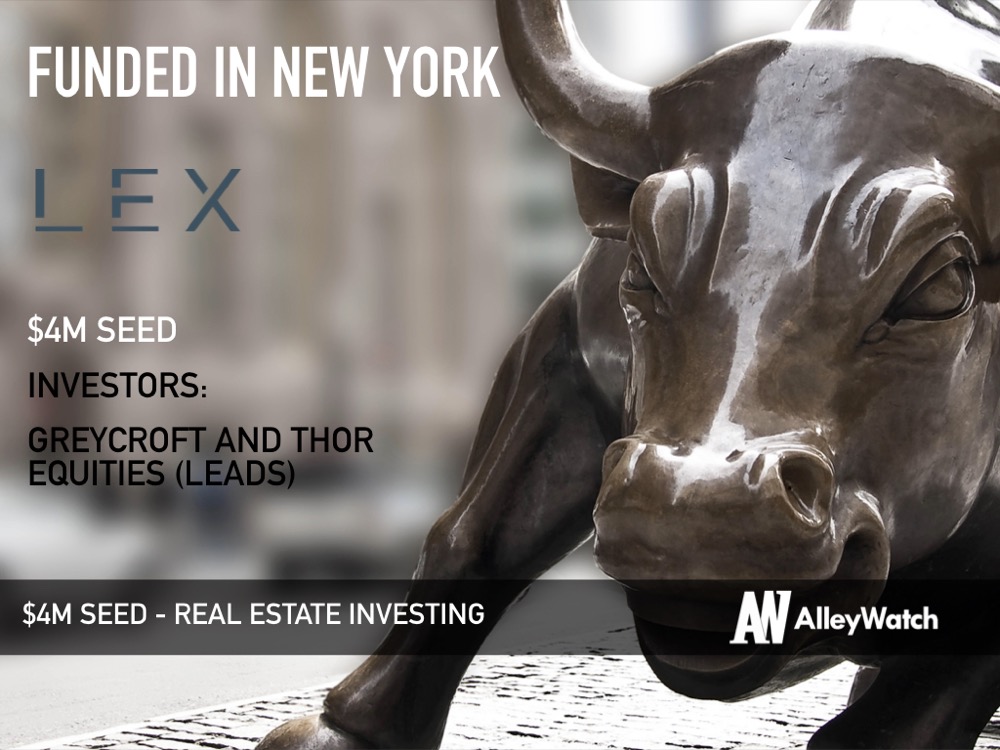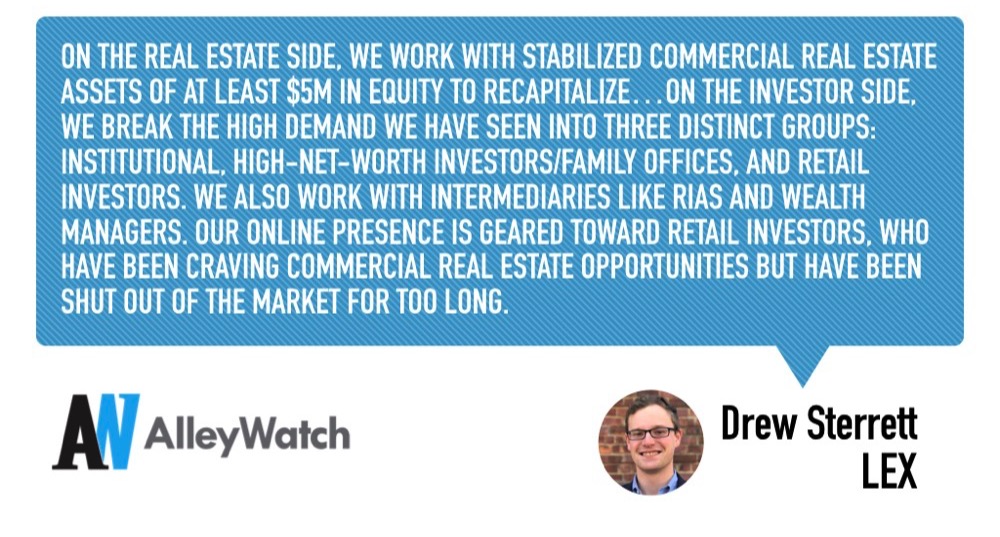You don’t need to be a multi-millionaire to start investing in commercial real estate now that LEX is on the market. LEX is the marketplace that allows non-accredited investors to build a diversified property portfolio, starting with shares that cost $100. Investors are able to transact through the company’s platform, providing the much-needed liquidity that has not been found in traditional commercial real estate investing. Property owners gain access to a new pool of capital while still maintaining operational control of properties.
AlleyWatch sat down with CEO Drew Sterrett to learn more about how LEX is democratizing commercial real estate investment, the company’s growth plans, and recent round of funding.
Who were your investors and how much did you raise?
LEX raised $4M in seed financing led by Greycroft and Thor Equities. Several other strategic investors also participated.
Tell us about the product or service that LEX offers.
LEX is a platform that allows investors to buy shares in individual, institutional-grade commercial real estate properties. Everyday Americans will be able to buy and sell shares, giving investors the flexibility to create customized income-producing real estate portfolios, and allowing property owners to unlock equity while retaining operational control of their properties. LEX is democratizing the commercial real estate asset class and redefining real estate investing.
What inspired you to start LEX?
LEX was born out of our personal desire to open up the real estate industry and our frustration with facing an opaque and illiquid market for the largest asset class in the world, only directly accessible to a small portion of investors. With this in mind, we sought to overcome the overarching problem which addresses the capital markets needs which have plagued both sides of the industry, for investors and real estate owners.
It’s all about access, transparency, and liquidity. We’re launching the first platform bringing single-property, freely tradable securities to market that are accessible to all – no exclusivity for accredited investors or institutions, and no restricted hold periods seen traditionally in private real estate investments.
Also, unlike other platforms, we are investing in building out a functioning secondary marketplace where buyers in initial offerings will be able to resell.
We believe our securities will be more attractive to investors because they have access to liquidity which has not been common to the asset class.
What market does LEX target and how big is it?
On the real estate side, we work with stabilized commercial real estate assets of at least $5M in equity to recapitalize. The total US commercial real estate market has been estimated at $13 trillion.
On the investor side, we break the high demand we have seen into three distinct groups: institutional, high-net-worth investors/family offices, and retail investors. We also work with intermediaries like RIAs and wealth managers. Our online presence is geared toward retail investors, who have been craving commercial real estate opportunities but have been shut out of the market for too long.
Who do you consider to be your main competitors?
Unlike startups that look to ‘disrupt’ an industry, we see ourselves as a value-add for both investors and property owners within the existing ecosystem. We view LEX as being a company that should have existed a long time ago and that can add value to other real estate investment vehicles such as REITs and private equity firms (many of whom we are working together with) to help provide them with liquidity and the ability to rebalance portfolios as needed.
What’s your business model?
Our revenue scales based on the amount of equity available on our platform. Real estate owners will pay a fee upon the successful close of each offering, and shareholders will pay a few basis points out of quarterly cash distributions. Another revenue source will be the secondary market trades on our ATS, which is in development.
What was the funding process like?
It’s exactly as stress-inducing as everyone says it is.
What are the biggest challenges that you faced while raising capital?
It’s hard to turn down the ‘wrong’ capital, but in the end, working with partners you trust and want to build your company with in the long-term is so important. We are very grateful to have found that with Greycroft and Thor as well as our other investors, as we understand it’s a luxury that not every company gets.
What factors about your business led your investors to write the check?
Both of our lead investors are positioned in areas where they have personally seen the pain-points we are looking to solve, so they understood first-hand the value that LEX can bring to both sides of the commercial real estate market.
Both of our lead investors are positioned in areas where they have personally seen the pain-points we are looking to solve, so they understood first-hand the value that LEX can bring to both sides of the commercial real estate market.
What are the milestones you plan to achieve in the next six months? Successfully place our early property offerings and facilitate our first secondary trades.
What advice can you offer companies in New York that do not have a fresh injection of capital in the bank?
Keep working to build your product and don’t let fundraising become your job, even if it seems counterintuitive. We’ve had our best success raising capital when it was not our primary priority and we were focused on continuing to reach our goals.
Where do you see the company going now over the near term?
We are excited to introduce a way for retail investors to invest in real estate deals alongside and on the same terms as institutional groups. We hope to bring our unique investment opportunities to as many individual investors as possible and increase our company’s visibility at an exciting time for the industry!






